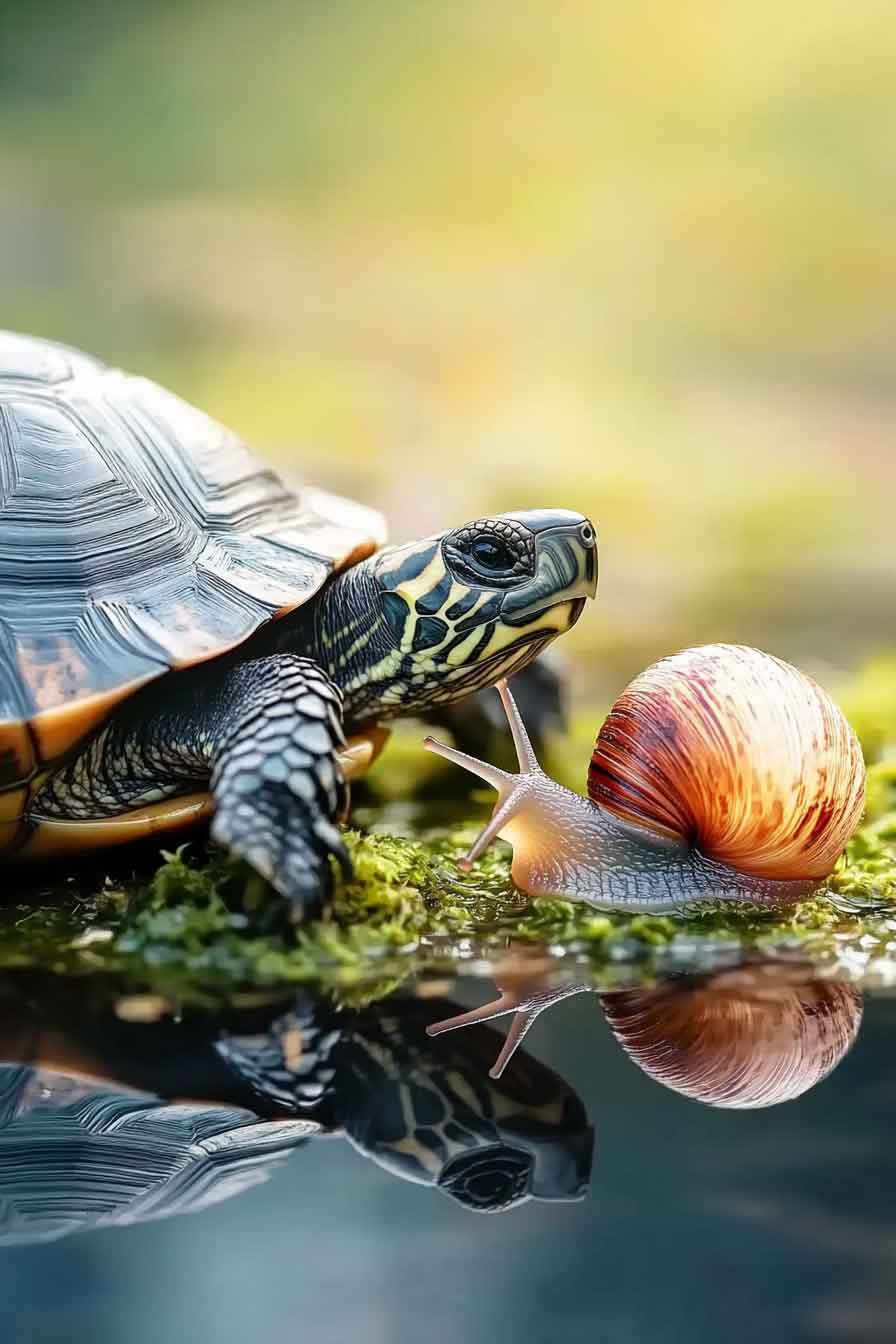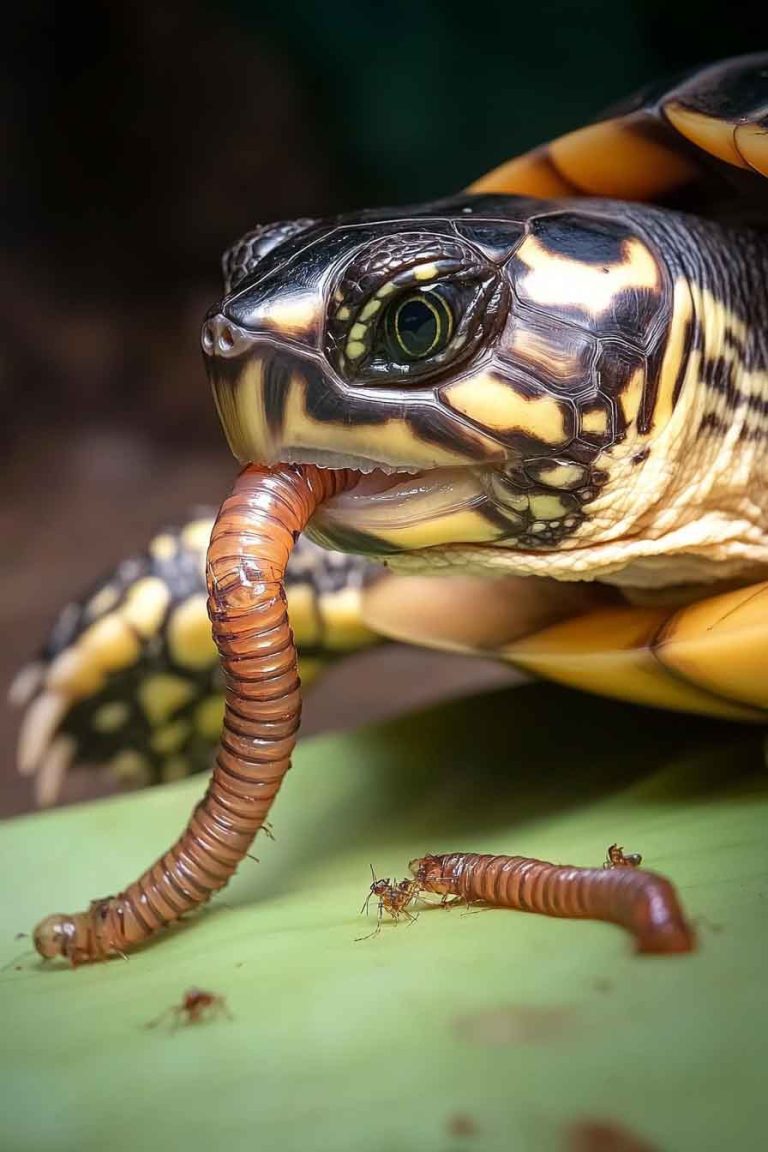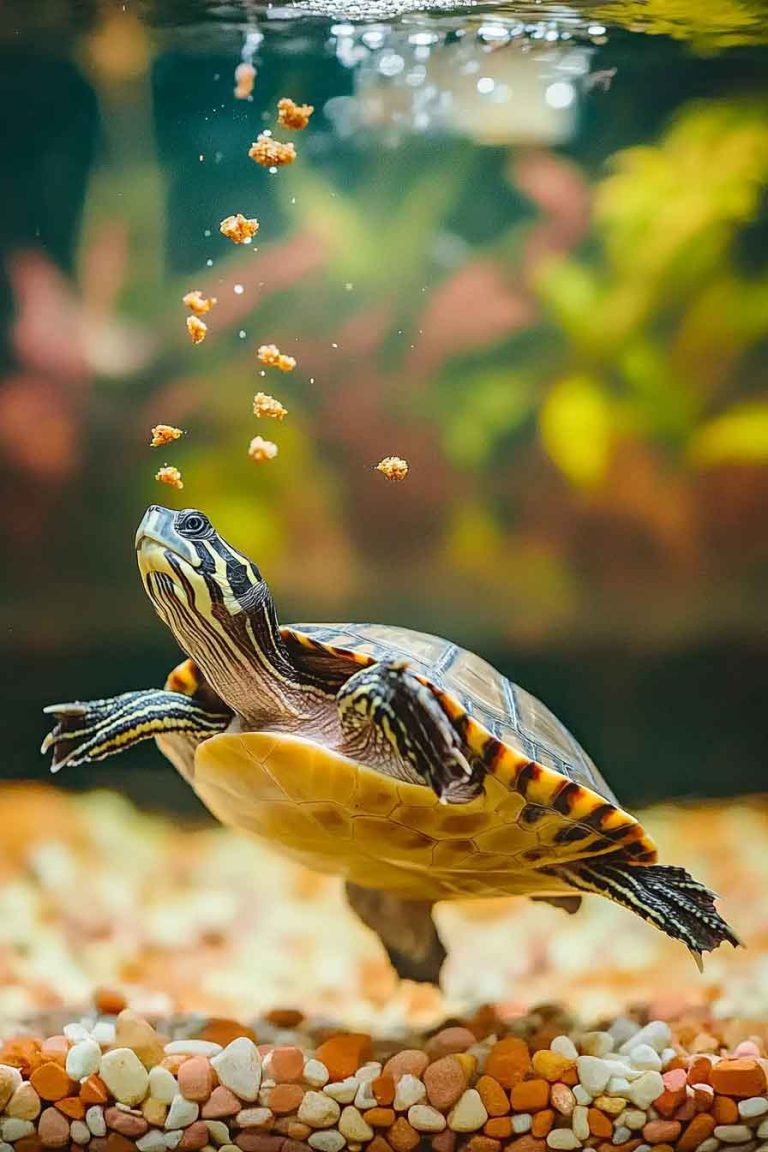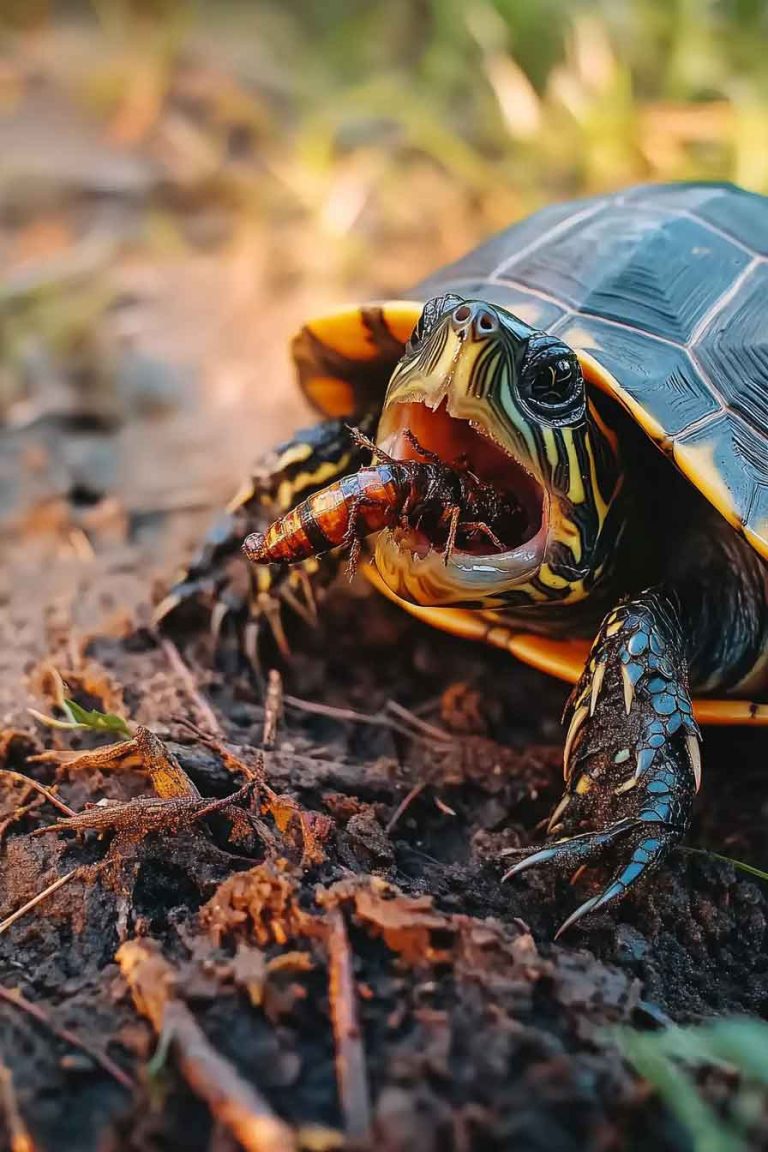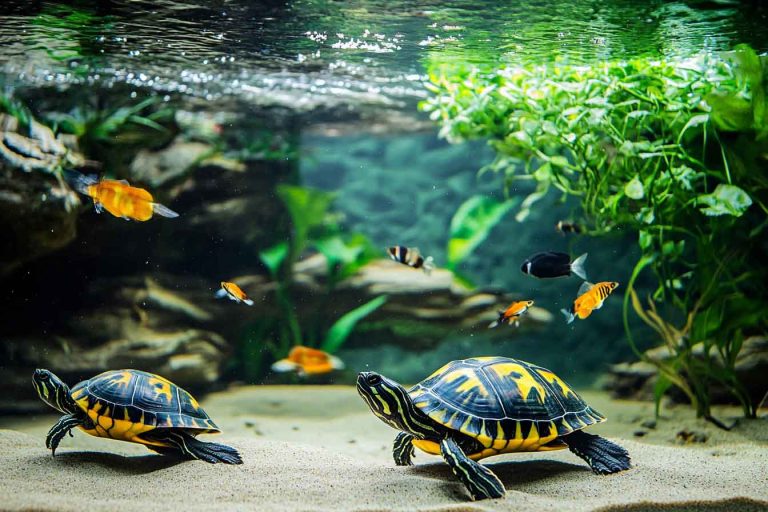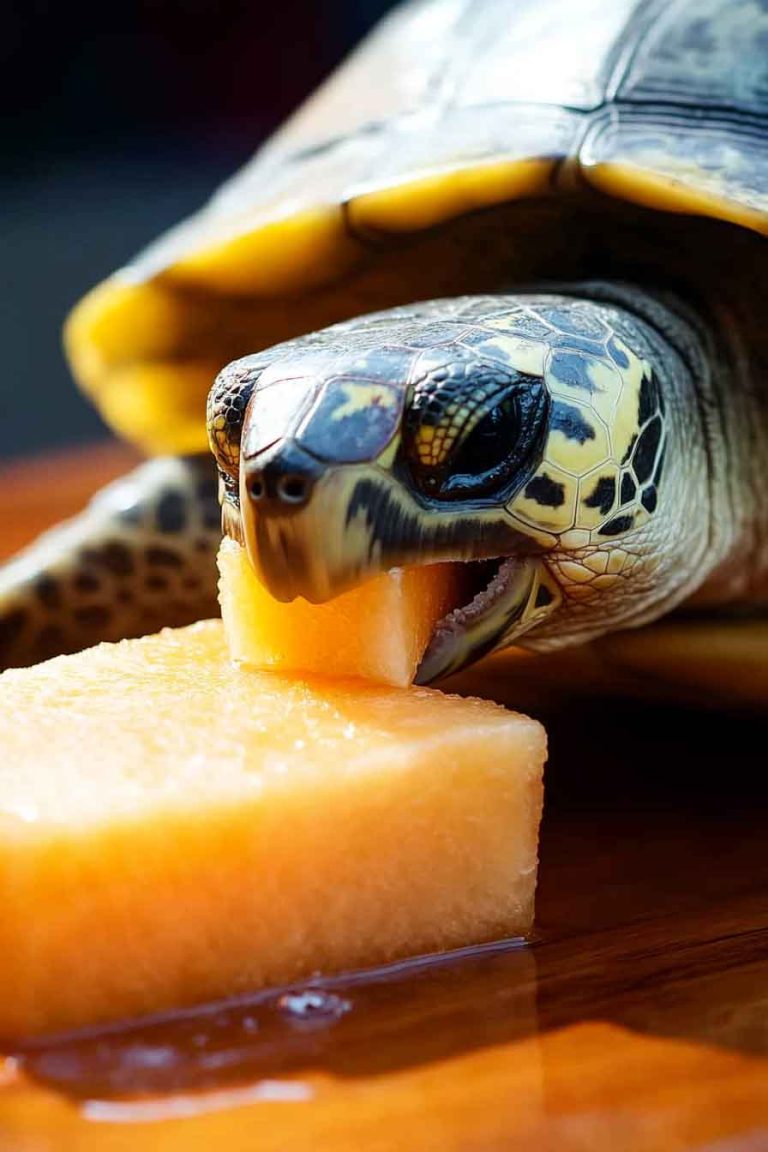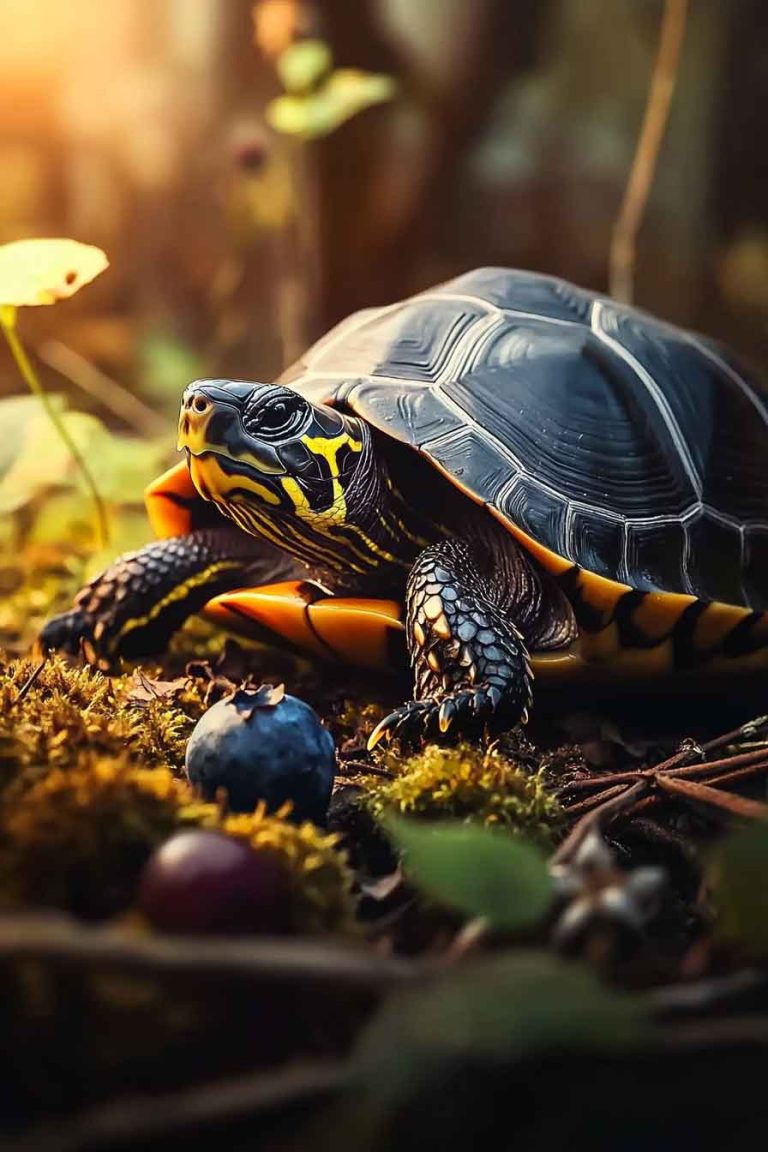Can Turtles Eat Snails? What You Must Know Before Feeding
If you’re like me and have fallen in love with keeping turtles as pets, you’ve probably wondered about expanding their diet beyond the usual commercial turtle food. One question that frequently pops up in turtle owner communities is whether our shelled friends can safely munch on snails. After years of turtle keeping and extensive research,…
If you’re like me and have fallen in love with keeping turtles as pets, you’ve probably wondered about expanding their diet beyond the usual commercial turtle food. One question that frequently pops up in turtle owner communities is whether our shelled friends can safely munch on snails. After years of turtle keeping and extensive research, I’m here to share everything you need to know about turtles and snails.
So, can turtles eat snails? Yes, turtles can eat snails! In fact, snails are a natural part of many turtle species’ diets in the wild. They provide excellent protein, calcium from their shells, and essential nutrients that can benefit your turtle’s health. However, like any food, there are important considerations about which snails are safe, how to prepare them, and how often to offer them.
In this comprehensive guide, I’ll walk you through everything about feeding snails to turtles, from the nutritional benefits to potential risks, and answer all the burning questions you might have about this protein-rich treat.
Can You Feed Snails To Your Pet Turtle?
The answer is absolutely yes – but with some important caveats. Unlike some foods that are completely off-limits to turtles, snails can be a fantastic addition to your turtle’s diet when done correctly.
I’ve been feeding snails to my turtles for years, and I’ve seen firsthand how much they enjoy this natural food source. Wild turtles regularly hunt and consume snails, so we’re essentially mimicking their natural feeding behavior.
Let me break down the nutritional profile of a typical pond snail (per 100 grams):
- Protein: 16.1 g
- Fat: 1.4 g
- Carbohydrates: 2.0 g
- Calcium: 1200 mg
- Phosphorus: 200 mg
- Iron: 17.5 mg
- Zinc: 2.3 mg
- Vitamin B12: 20 mcg
- Magnesium: 250 mg
This nutritional breakdown shows exactly why snails are such a valuable food source for turtles. The high protein content supports healthy growth and shell development, while the impressive calcium levels help maintain strong shells and bones.
What makes snails particularly excellent for turtles is the calcium-to-phosphorus ratio. With approximately 6:1 calcium to phosphorus, snails far exceed the ideal 2:1 ratio that turtles need. This means they’re actually helping to balance out other foods that might be higher in phosphorus.
The iron content is also noteworthy, as many captive turtles can suffer from iron deficiency. The natural B12 found in snails supports neurological function and red blood cell formation.
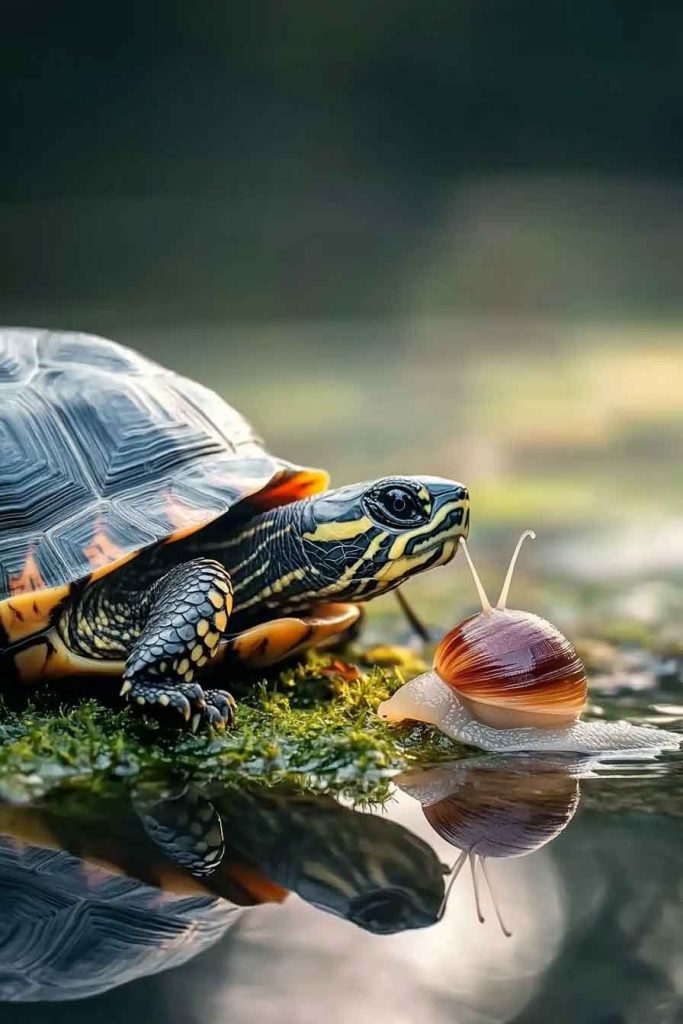
Do Turtles Like Snails?
In my experience, most turtles absolutely love snails! I remember the first time I offered a pond snail to my red-eared slider – the excitement was unmistakable. There’s something about the hunt and the crunch that really appeals to their predatory instincts.
Different turtle species show varying levels of enthusiasm for snails. Aquatic turtles tend to be more aggressive hunters and will actively pursue moving snails in their tanks. Semi-aquatic species are also quite fond of them, while some terrestrial species might need a bit more encouragement.
The hunting behavior is fascinating to watch. Aquatic turtles will often stalk snails, waiting for the perfect moment to strike. The satisfying crunch as they break through the shell seems to provide both nutritional and psychological satisfaction.
Health Benefits of Turtles Eating Snails
After incorporating snails into my turtles’ diets, I’ve noticed several positive changes that align with what veterinarians and reptile nutritionists recommend:
Superior Shell Development
The high calcium content in snails contributes significantly to shell health. I’ve observed stronger, more vibrant shell growth in turtles that regularly consume snails compared to those on commercial diets alone.
The calcium in snail shells is highly bioavailable, meaning turtles can easily absorb and utilize it. This is crucial for preventing metabolic bone disease and ensuring proper shell development, especially in growing juveniles.
Enhanced Protein Intake
The protein quality in snails is exceptional. Unlike some commercial turtle foods that rely on plant-based proteins, snail protein contains all essential amino acids that turtles need for muscle development, organ function, and overall growth.
I’ve particularly noticed improved muscle tone and energy levels in my turtles since adding snails to their diet rotation.
Natural Foraging Behavior
Offering live or fresh snails encourages natural hunting and foraging behaviors that keep turtles mentally stimulated. This behavioral enrichment is just as important as nutritional benefits.
Watching my turtles hunt snails provides them with mental stimulation and physical exercise, which helps prevent the lethargy and boredom that can affect captive reptiles.
Digestive Health Support
The natural enzymes and beneficial bacteria found in fresh snails can support healthy digestion. Unlike processed foods, snails provide probiotics that help maintain gut health.
Can Turtles Eat Snail Shells?
This is one of the most common questions I receive from fellow turtle enthusiasts. Yes, turtles can and should eat snail shells! The shells are actually one of the most beneficial parts of the snail.
Snail shells are primarily composed of calcium carbonate, the same material that makes up turtle shells. When turtles crunch through snail shells, they’re getting a concentrated dose of easily absorbable calcium.
I’ve watched my turtles systematically crunch through entire snail shells, and their powerful jaws are perfectly designed for this task. The crunching action also helps keep their beaks properly worn down, which is important for dental health.
However, there are a few considerations:
- Very large shells might be difficult for smaller turtles to manage
- Sharp shell fragments could potentially cause minor cuts, though this is rare
- Some turtles prefer to extract the soft body and leave larger shell pieces
If you’re concerned about shell size, you can lightly crush larger snails before offering them, making it easier for your turtle to consume the entire snail.
Best Snails for Turtle Tank
After years of experimenting with different snail species, I’ve identified several excellent options for turtle tanks. The key is choosing snails that are safe, nutritious, and appropriately sized for your turtle.
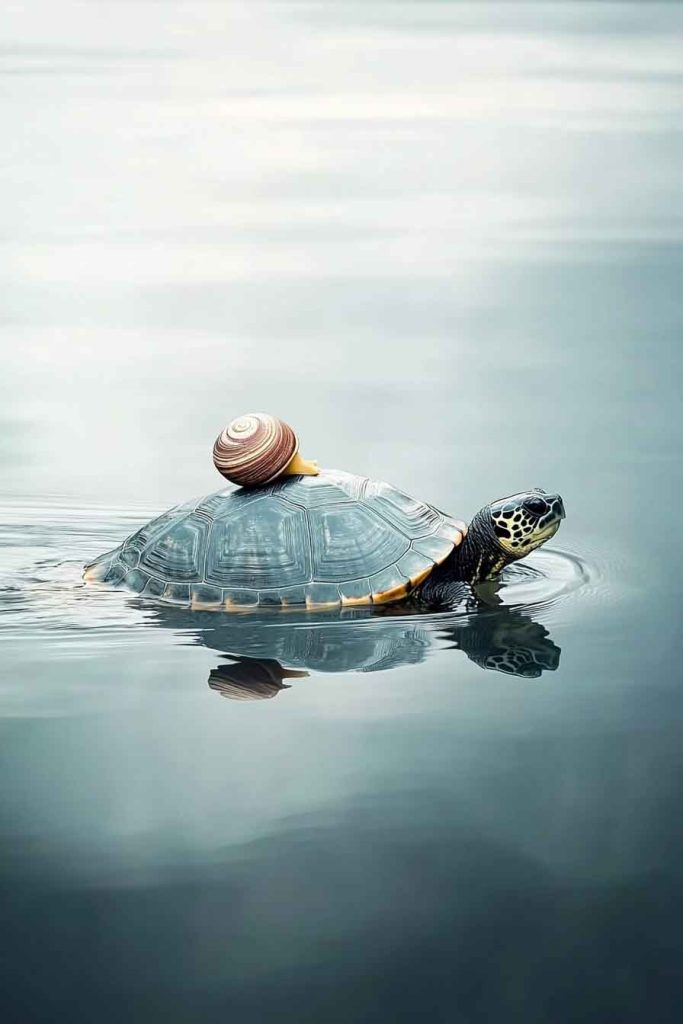
Pond Snails (Lymnaea species)
These are my go-to choice for most turtle tanks. They’re readily available, reproduce easily, and are the perfect size for most turtle species. Pond snails are excellent algae eaters, so they serve a dual purpose in your tank ecosystem.
I maintain a separate breeding tank for pond snails to ensure a steady supply. They reproduce quickly and can help maintain your turtle tank’s water quality by consuming algae and organic debris.
Ramshorn Snails (Planorbarius corneus)
These attractive spiral-shelled snails are another excellent choice. They’re slightly larger than pond snails, making them perfect for adult turtles. Their shells provide substantial calcium content, and they’re quite active, which triggers hunting behavior.
Ramshorn snails are particularly hardy and can tolerate a wide range of water conditions, making them ideal for turtle tanks that might have fluctuating parameters.
Apple Snails (Pomacea species)
For larger turtle species, apple snails can provide a substantial meal. However, I recommend these primarily for adult turtles due to their size. The calcium content is exceptional, and the larger soft body provides plenty of protein.
Be aware that apple snails can grow quite large, so they’re best suited for adult turtles or can be offered in pieces to smaller turtles.
Bladder Snails (Physella acuta)
These small snails are perfect for juvenile turtles or as supplementary food for adults. They reproduce rapidly and are excellent for maintaining a continuous food supply in your turtle habitat.
Snails to Avoid
Not all snails are suitable for turtle consumption:
- Terrestrial garden snails: These may carry parasites or have been exposed to pesticides
- Marine/saltwater snails: Not appropriate for freshwater turtles
- Unknown wild-caught snails: Risk of parasites or toxin exposure
- Snails from polluted water sources: May contain harmful chemicals
Do Red-Eared Slider Turtles Eat Snails?
As someone who has kept red-eared sliders for over a decade, I can confidently say they are enthusiastic snail hunters! Red-eared sliders are omnivorous with strong predatory instincts, and snails represent the perfect combination of accessible prey and nutritional value.
In the wild, red-eared sliders actively hunt aquatic snails, and this behavior translates perfectly to captivity. I’ve observed my sliders using sophisticated hunting strategies, including:
- Waiting motionless near snail congregations
- Using their claws to flip over snails
- Systematically searching substrate for hidden snails
Red-eared sliders particularly benefit from snails because they have high calcium requirements for their rapid growth rate and large size. The calcium-rich shells help support their substantial shell development needs.
I recommend offering snails to red-eared sliders 2-3 times per week, rotating with other protein sources like fish, insects, and commercial turtle foods. This variety ensures balanced nutrition while satisfying their hunting instincts.
Do Painted Turtles Eat Snails?
Painted turtles are excellent snail consumers! Their natural diet includes a significant portion of aquatic invertebrates, with snails being a primary component. I’ve kept several painted turtle subspecies, and all have shown strong preferences for snails.
What makes painted turtles particularly effective snail hunters is their patient hunting style. Unlike some more aggressive species, painted turtles often employ a “wait and ambush” strategy that’s perfectly suited for snail hunting.
The nutritional needs of painted turtles align perfectly with what snails provide. They require substantial calcium for shell health and protein for their active lifestyle. The smaller mouth size of painted turtles compared to species like red-eared sliders makes them ideal candidates for smaller snail species like pond snails and bladder snails.
I’ve found that painted turtles are particularly responsive to live snails. The movement triggers their predatory response more effectively than static food items.
Do Box Turtles Eat Snails?
Box turtles are enthusiastic snail consumers, though their approach differs from aquatic species. As semi-terrestrial turtles, box turtles encounter snails both in water and on land, making them adaptable snail hunters.
In my experience keeping box turtles, they show remarkable skill at extracting snails from shells. Their powerful jaws can easily crack even larger snail shells, and they seem to particularly enjoy the process.
Box turtles benefit greatly from the calcium in snail shells because they spend significant time on land where calcium sources can be scarce. The high-quality protein supports their active foraging lifestyle.
I offer snails to my box turtles both in their water dishes and scattered around their terrestrial habitat. This mimics natural foraging conditions and provides environmental enrichment.
For box turtles, I particularly recommend:
- Medium-sized pond snails
- Ramshorn snails
- Occasionally larger apple snails for adults
The key is ensuring the snails are from clean, safe sources since box turtles have more sensitive digestive systems than purely aquatic species.
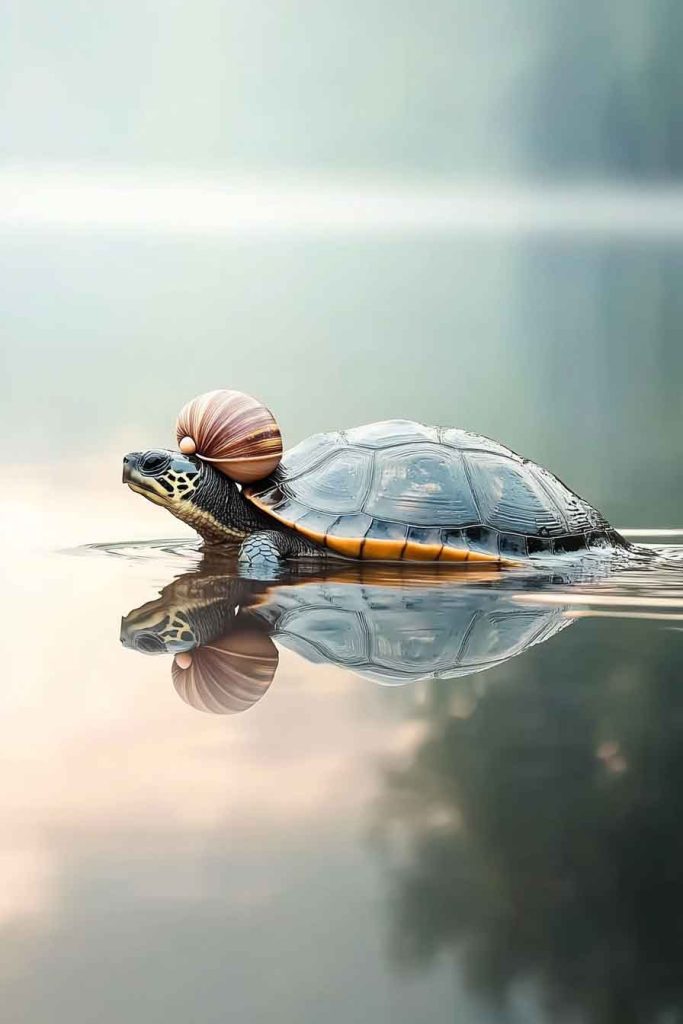
Can Snails and Turtles Live Together?
This is a fascinating question that many turtle keepers grapple with. The short answer is: it’s possible, but it requires careful management and realistic expectations.
I’ve successfully maintained “snail colonies” in turtle tanks, though it’s more accurate to call it managed farming rather than peaceful coexistence. The key is understanding that turtles will eat snails – that’s natural behavior – but you can create conditions where snail populations can sustain themselves.
Creating a Sustainable System
Here’s how I’ve managed snail and turtle cohabitation:
Population Balance: Start with a substantial snail population – at least 20-30 snails for every turtle. This allows the colony to reproduce faster than the turtles can consume them.
Hiding Places: Provide plenty of hiding spots where snails can retreat and reproduce. I use dense aquatic plants, rock caves, and driftwood to create snail refuges.
Feeding Strategy: Well-fed turtles are less aggressive hunters. When my turtles are satisfied with their regular diet, they’re less likely to actively hunt every snail they see.
Species Selection: Fast-reproducing species like pond snails and bladder snails work best. Slower-reproducing species like apple snails will likely be consumed faster than they can replace themselves.
Managing Expectations
Even with careful planning, the snail population will fluctuate dramatically. I’ve had periods where snails seemed to disappear entirely, only to rebound weeks later from hidden eggs.
Some turtles are more aggressive hunters than others. I’ve had individual turtles that would systematically hunt down every snail, while others showed minimal interest.
Benefits of Cohabitation
When successful, this arrangement provides:
- Continuous natural food source for turtles
- Excellent water quality management (snails consume algae and debris)
- Natural behavioral stimulation
- Reduced feeding costs
- Dynamic, living ecosystem
Challenges
- Unpredictable population swings
- Potential for complete snail elimination
- Requires larger, well-established tanks
- May not work with particularly aggressive turtle species
How to Safely Introduce Snails to Your Turtle’s Diet
Based on my years of experience, here’s my step-by-step approach to safely introducing snails:
Step 1: Source Selection
Always obtain snails from reputable suppliers or establish your own breeding colony. I maintain separate snail tanks specifically for turtle food production. This ensures the snails are healthy and free from parasites or contaminants.
Avoid wild-caught snails unless you’re absolutely certain of their source water quality and health status.
Step 2: Quarantine Period
Even with trusted sources, I quarantine new snails for 2-3 weeks in a separate tank. This allows me to observe them for signs of illness or parasites before introducing them to my turtle habitat.
During quarantine, feed the snails high-quality foods like algae wafers and blanched vegetables to ensure they’re nutritionally dense when consumed.
Step 3: Size Matching
Match snail size to your turtle species:
- Hatchling turtles: Tiny bladder snails or juvenile pond snails
- Juvenile turtles: Small to medium pond snails
- Adult turtles: Any appropriate species, including larger apple snails
Step 4: Gradual Introduction
Start by offering 1-2 snails per turtle, 2-3 times per week. Monitor your turtle’s response and digestive health. Healthy turtles should show enthusiasm for hunting and have normal bowel movements.
Step 5: Monitor and Adjust
Watch for signs of digestive upset, which are rare but possible. If your turtle shows reluctance to eat snails, try different species or preparation methods.
Potential Risks and Precautions
While snails are generally safe and beneficial, there are some considerations every responsible turtle owner should understand:
Parasite Risk
Wild-caught or poorly sourced snails can carry parasites that affect turtles. This is why I always recommend controlled breeding or reputable suppliers.
Signs of parasitic infection include:
- Changes in appetite
- Abnormal bowel movements
- Lethargy or behavioral changes
- Weight loss despite normal eating
Overfeeding
Snails are rich in protein and should be part of a balanced diet, not the sole food source. Overfeeding protein can lead to kidney stress and shell pyramiding in some species.
I recommend snails comprise no more than 30% of your turtle’s total protein intake.
Water Quality Impact
Large quantities of snail shells and waste can impact water quality. Ensure adequate filtration and regular water changes when regularly feeding snails.
Size Appropriateness
Always match snail size to your turtle’s capabilities. Very large snails might be difficult for smaller turtles to handle safely.
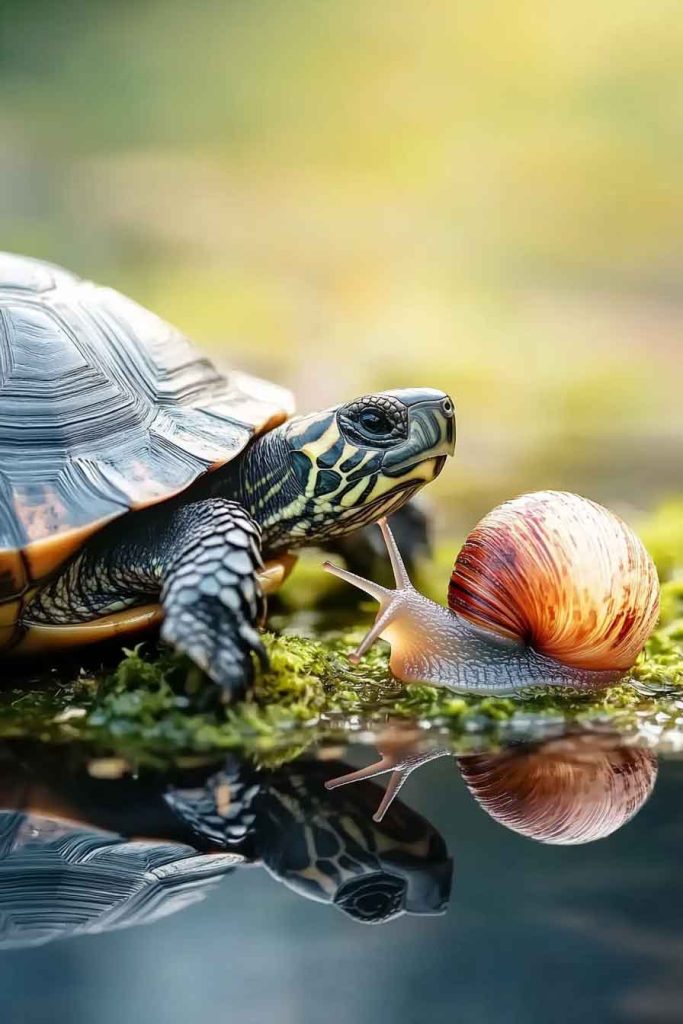
Frequency and Portion Guidelines
Based on my feeding experience and veterinary recommendations, here are my guidelines for snail feeding:
Adult Turtles (2+ years)
- Frequency: 2-3 times per week
- Quantity: 2-4 snails per feeding, depending on snail and turtle size
- Integration: Rotate with other protein sources
Juvenile Turtles (6 months – 2 years)
- Frequency: 3-4 times per week
- Quantity: 1-3 small snails per feeding
- Focus: Support rapid growth with high-quality protein
Hatchling Turtles (under 6 months)
- Frequency: Daily small amounts
- Quantity: 1-2 tiny snails or snail pieces
- Preparation: May need to crush shells for easier consumption
Seasonal Adjustments
I adjust feeding frequency based on seasonal activity levels:
- Spring/Summer: Higher frequency due to increased activity
- Fall/Winter: Reduced frequency as metabolism slows
Preparing Snails for Your Turtle
Proper preparation ensures safety and maximizes nutritional benefit:
Live Snails
Live snails provide the best nutritional value and behavioral enrichment. Simply place them in the turtle habitat and let natural hunting commence.
Ensure live snails are from clean, controlled sources and have been properly quarantined.
Fresh-Killed Snails
For turtles that struggle with live prey or when portion control is important, freshly killed snails work well. I quick-freeze snails to dispatch them humanely, then thaw before feeding.
Shell Crushing
For smaller turtles or those with difficulty handling larger shells, lightly crush the shell before offering. This maintains most benefits while making consumption easier.
Supplemental Preparation
Some turtle keepers dust snails with calcium powder, though this is generally unnecessary given the high natural calcium content. I prefer to focus on variety in the overall diet instead.
Frequently Asked Questions (FAQs)
Can Baby Turtles Eat Snails? Yes, baby turtles can eat snails, but they need appropriately sized prey. I offer tiny bladder snails or pieces of larger snails to hatchlings. The high calcium content is particularly beneficial for growing shells.
Are Garden Snails Safe for Turtles? I don’t recommend garden snails due to potential pesticide exposure and parasite risk. Stick to aquatic species from controlled sources for maximum safety.
How Many Snails Should I Feed My Turtle? This depends on turtle size and snail size. As a general rule, 2-4 snails per feeding, 2-3 times per week for adult turtles. Adjust based on your turtle’s response and overall diet composition.
Can Turtles Eat Snail Eggs? Yes, turtles can eat snail eggs, and they’re actually quite nutritious. The eggs are easy to digest and provide protein without the calcium load of shells.
Do All Turtle Species Eat Snails? Most turtle species will eat snails, though preferences vary. Aquatic and semi-aquatic species tend to be more enthusiastic snail hunters than purely terrestrial species.
Can Snails Make My Turtle Sick? When sourced properly, snails are very safe for turtles. The main risks come from wild-caught snails that may carry parasites or contaminants. Always use reputable sources.
Conclusion
After years of incorporating snails into my turtles’ diets, I can confidently say they’re one of the best natural food sources available to turtle keepers. The combination of high-quality protein, essential calcium, and behavioral enrichment makes snails an invaluable addition to any turtle’s nutrition plan.
The key to success is proper sourcing, appropriate sizing, and integration into a balanced diet. Whether you choose to maintain a breeding colony, purchase from suppliers, or create a sustainable tank ecosystem, snails can significantly enhance your turtle’s health and quality of life.
Remember, every turtle is an individual, and what works perfectly for my turtles might need adjustment for yours. Start slowly, observe your turtle’s response, and don’t hesitate to consult with a reptile veterinarian if you have specific concerns about your turtle’s diet.
The natural hunting behavior that snails encourage, combined with their exceptional nutritional profile, makes them one of my top recommendations for turtle keepers looking to provide the most natural and beneficial diet possible. Your turtles will thank you with improved health, enhanced activity levels, and the satisfaction that comes from expressing their natural behaviors.

